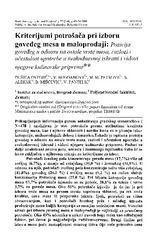Приказ основних података о документу
Criteria of consumers when purchasing beef in retail stores: Position of beef compared to other meat types, reasons and frequency of its use in everyday nutrition and preparation methods
Kriterijumi potrošača pri izboru goveđeg mesa u maloprodaji - pozicija goveđeg u odnosu na ostale vrste mesa, razlozi i učestalost upotrebe u svakodnevnoj ishrani i vidovi njegove kulinarske pripreme
| dc.creator | Ostojić Andrić, Dušica | |
| dc.creator | Bogdanović, Vladan | |
| dc.creator | Petrović, Milan M. | |
| dc.creator | Aleksić, S. | |
| dc.creator | Miščević, Branislav | |
| dc.creator | Pantelić, Vlada | |
| dc.date.accessioned | 2018-12-14T14:43:31Z | |
| dc.date.available | 2018-12-14T14:43:31Z | |
| dc.date.issued | 2006 | |
| dc.identifier.issn | 1450-9156 | |
| dc.identifier.uri | http://r.istocar.bg.ac.rs/handle/123456789/84 | |
| dc.description.abstract | Information was collected by conducting poll of the town residents (N=478) in which their attitude towards the traits of beef quality, as well as their habits and inclinations in regard to the choice of category, retail cuts and giblets were analyzed. Also, the position of beef compared to other meat types was studied, reasons and frequency of meat consumption in every day nutrition and preparation methods. Data were further analyzed according to sex, age and occupation of participants in the poll in order to come to conclusion about their effect on the meat selection criteria. Female consumers consume beef (17,7%) more than mutton (6,7%), and less than pork (39,0 %) and poultry meat (36,5%). Compared to them, male consumers consume more pork (41,8%), beef (26,0 %) and mutton (9,2 %) and less poultry meat (23,0 %). When choosing the category of beef, 67,7% of consumers selected young beef, 28,6% veal and only 3,7% beef. Approx. 50% of consumers declared that the first thing when selecting meat category is their inclination, followed by quality, price or recommendation by doctor. However, consumers with higher education, as well as female and younger consumers prefer meat with lower fat content. Visual impression when choosing young beef in retail stores is most important for average consumer. Approx. 43% of participants in the poll stated color of meat as decisive factor, red-pink color is desired. Second factor when choosing beef is presence of fatty tissue more appreciated by male and older consumers which find it more tasteful. Young beef is most often consumed once a week (60%), mainly cooked, in soups or stews, with special inclination of male consumers towards smoked beef. Consumers mainly buy breasts and ribs (40%), and rarely beef steaks (2,5%), in other words dishes containing beef with bones are most often prepared, as well as dishes containing mixed ground meat. The use of giblets is rare, especially among female population, liver, hearts and beef stomach (so called "škembić") and tongue are mainly used. | en |
| dc.description.abstract | Prikupljanjem informacija putem anketiranja gradskog stanovništva ( N=478 ) analiziran je stav potrošača prema atributima kvaliteta goveđeg mesa, kao i njihove sklonosti i navike kada su u pitanju izbor kategorije, maloprodajnih delova i iznutrica.Takođe je ispitana pozicija goveđeg u odnosu na ostale vrste mesa, razlozi i učestalost upotrebe u svakodnevnoj ishrani i vidovi njegove kulinarske pripreme. Podaci su dalje analizirani prema polu, uzrastu i zanimanju ispitanika kako bi se izveo zaključak o njihovom uticaju na kriterijume za izbor. Potrošači ženskog pola konzumiraju goveđe meso (17,7%) više od ovčijeg (6,7%), a manje od svinjskog (39,0 %) i živinskog (36,5%). U odnosu na njih, potrošači muškog pola konzumiraju nešto više svinjskog (41,8%), goveđeg (26,0 %) i ovčijeg mesa (9,2 %) na račun slabije konzumacije živinskog mesa (23,0 %). Pri izboru kategorije goveđeg mesa 67,7% potrošača izjasnilo se za juneće, 28,6% za teleće i samo 3,7% za goveđe meso. Oko 50% potrošača izjavilo je da im je pri izboru vrste mesa na prvom mestu sopstvena sklonost, pa tek onda kvalitet, cena mesa ili preporuka lekara. Ipak, potrošači sa višim obrazovanjem, kao i potrošači ženskog pola i mlađeg uzrasta preferiraju meso boljih kategorija sa manjim sadržajem masti. Vizuelni utisak pri izboru junećeg mesa u maloprodaji je najbitniji za prosečnog potrošača. Oko 43% učesnika u anketi navodi boju mesa kao odlučujući faktor, pri čemu je najpoželjnija ružičasto-crvena. Drugi činilac pri izboru mesa jeste zastupljenost masnog tkiva čije veće prisustvo cene potrošači muškog pola i starijeg uzrasta smatrajući ga ukusnijim. Junetina se najčešće (60%) konzumira jedanput nedeljno i to kuvana, u vidu supa ili variva, uz posebnu naklonjenost muškog pola dimljenom junećem mesu. Potrošači najčešće kupuju juneće grudi i rebra (40%), a najređe biftek (2,5%), odnosno najčešće pripremaju jela od goveđeg mesa sa kostima, kao i od mešanog mlevenog mesa. Upotreba iznutrica je slabo izražena, posebno u ženskoj populaciji, pri čemu se najčešće koriste jetra, srce, juneći želudac (tzv. škembić) i jezik. | sr |
| dc.publisher | Institute for Animal Husbandry, Belgrade | |
| dc.relation | Ministry of Science, Republic of Serbia, no. TR-6877B: Unapređenje tehnoloških procesa i kvaliteta proizvoda u industriji hrane za životinje | |
| dc.rights | openAccess | |
| dc.rights.uri | https://creativecommons.org/licenses/by/4.0/ | |
| dc.source | Biotechnology in Animal Husbandry | |
| dc.subject | young beef and beef | en |
| dc.subject | quality | en |
| dc.subject | choice | en |
| dc.subject | consumer | en |
| dc.subject | poll | en |
| dc.subject | juneće i goveđe meso | sr |
| dc.subject | kvalitet | sr |
| dc.subject | izbor | sr |
| dc.subject | potrošač | sr |
| dc.subject | anketa | sr |
| dc.title | Criteria of consumers when purchasing beef in retail stores: Position of beef compared to other meat types, reasons and frequency of its use in everyday nutrition and preparation methods | en |
| dc.title | Kriterijumi potrošača pri izboru goveđeg mesa u maloprodaji - pozicija goveđeg u odnosu na ostale vrste mesa, razlozi i učestalost upotrebe u svakodnevnoj ishrani i vidovi njegove kulinarske pripreme | sr |
| dc.type | article | |
| dc.rights.license | BY | |
| dc.citation.volume | 22 | |
| dc.citation.issue | 3-4 | |
| dc.citation.spage | 45 | |
| dc.citation.epage | 53 | |
| dc.citation.other | 22(3-4): 45-53 | |
| dc.identifier.doi | 10.2298/BAH0604045O | |
| dc.identifier.fulltext | http://r.istocar.bg.ac.rs//bitstream/id/2334/82.pdf | |
| dc.type.version | publishedVersion |


